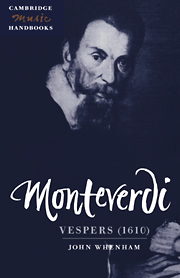Book contents
- Frontmatter
- Contents
- Acknowledgements
- List of abbreviations
- 1 Introduction
- 2 The 1610 settings and the liturgy of Vespers
- 3 The 1610 print and Monteverdi's career
- 4 ‘Suited to the chapels or chambers of princes’
- 5 ‘And all on a cantus firmus’
- 6 Issues of performance
- Appendices
- 1 Second Vespers for the Feast of the Assumption of the Blessed Virgin (15 August)
- 2 Plainsongs, texts and translations
- Notes
- Select bibliography
- Discography
- Index
2 - Plainsongs, texts and translations
Published online by Cambridge University Press: 12 January 2010
- Frontmatter
- Contents
- Acknowledgements
- List of abbreviations
- 1 Introduction
- 2 The 1610 settings and the liturgy of Vespers
- 3 The 1610 print and Monteverdi's career
- 4 ‘Suited to the chapels or chambers of princes’
- 5 ‘And all on a cantus firmus’
- 6 Issues of performance
- Appendices
- 1 Second Vespers for the Feast of the Assumption of the Blessed Virgin (15 August)
- 2 Plainsongs, texts and translations
- Notes
- Select bibliography
- Discography
- Index
Summary
This Appendix contains the texts, with translations, of all the items that Monteverdi published under the heading ‘Vespro della B[eata] Vergine’ in his 1610 print, together with plainsongs for the versicle and response, the psalms, hymn, sonata and Magnificat. In the case of this latter group, the texts and plainsongs represent an attempt to establish as nearly as possible the raw materials with which Monteverdi worked. A fundamental problem for both historians and analysts is that we do not know on which liturgical sources Monteverdi drew for his texts and plainsongs. One thing is certain, however: that LU, which is so often used in analyses of the 1610 Vespers, is an unsuitable starting point for such endeavours.
A comparison between the readings of the 1610 print and modern compilations of liturgical texts and plainsongs such as LU and the Antiphonale Monasticum (henceforth AM) reveals a number of small, but interesting variants. An obvious question that these raise is whether they represent standard Roman usage in the late sixteenth and early seventeenth centuries, or whether Monteverdi was working from a local use, such as that of the ducal church of Santa Barbara in Mantua.
The variants are:
‘Dixit Dominus’, verse 4: in Monteverdi's setting (bar 52 (Bt 100)) the first part of the verse ends after ‘virtutis tuae’ and not after ‘in splendoribus sanctorum’;
‘Lœtatus sum’, verse 4: in Monteverdi's setting (bars 42–3 (Bt 73–6; St 41–2)) the first part of the verse ends after ‘testimonium Israel’ rather than after ‘tribus Domini’;
‘Dixit Dominus’, verse 8: all but one of the part-books have ‘bibit’ instead of ‘bibet’ (the final syllable is missing in the Bassus part); further, while the A, T, B, Q and S part-books have ‘exaltabit’, the Cantus part has ‘exaltavit’.
[…]
- Type
- Chapter
- Information
- Monteverdi: Vespers (1610) , pp. 100 - 120Publisher: Cambridge University PressPrint publication year: 1997

